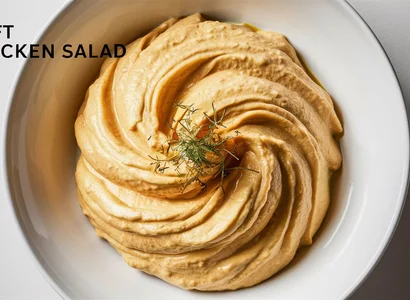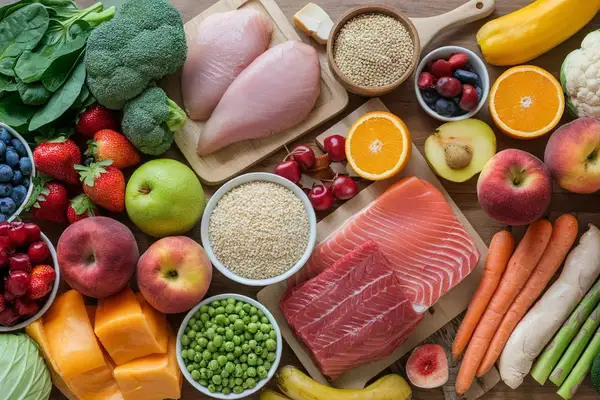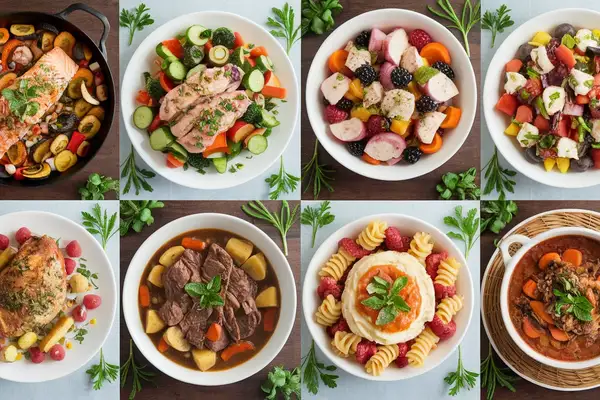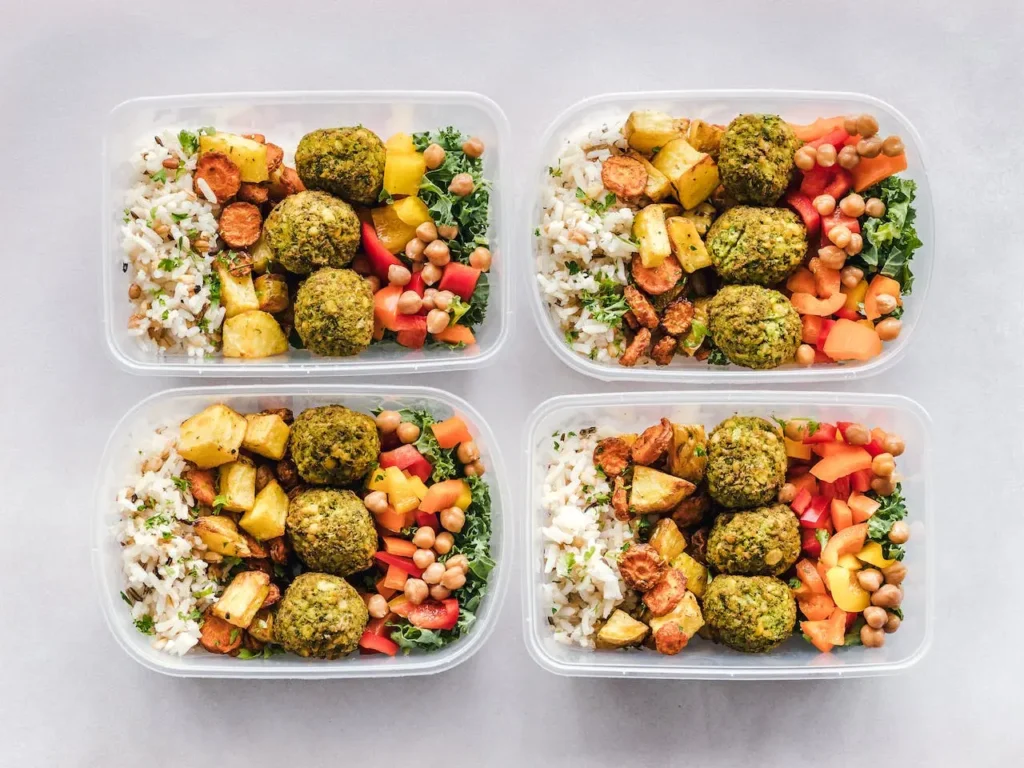Gastric Bypass Diet Plan: Safe Foods To Eat After Surgery

This post may contain affiliate links, meaning I may earn a commission if you make a purchase, at no extra cost to you. I only recommend products I trust. Thank you for your support.
Gastric bypass surgery is a life-changing procedure designed to help individuals struggling with obesity achieve significant weight loss. However, the journey doesn’t end with the surgery.
This surgical intervention necessitates a dedicated dietary regimen both before and after the procedure to ensure optimal outcomes and minimize complications.
The pre-gastric bypass surgery diet or bariatric diet focuses on reducing fat around the liver, facilitating a safer and less invasive operation.
The post-gastric bypass surgery diet is structured into four phases to aid recovery, promote nutritional adequacy, and instill healthier eating habits.
Adhering to these dietary guidelines is crucial for the success of the surgery and the long-term health of the patient.
In this article, we shall provide you with a gastric bypass diet plan and healthy gastric diet recipes for each stage after surgery.
Additionally, we shall provide you with safe gastric bypass foods to eat and gastric bypass foods to avoid to guide you through your new dietary journey.
Gastric Bypass Foods to Eat
After the gastric bypass surgery, your diet must be carefully planned to ensure you get the necessary nutrients.
Here’s a detailed list of foods you should include in your gastric bypass diet:
Proteins
Protein is essential for muscle repair, tissue building, and overall recovery. Aim for 60-100 grams of protein per day.
- Skinless Chicken: Lean source of protein, easy to prepare in various ways such as grilled or baked.
- Lean Beef or Pork: Choose lean cuts; ground beef or pork can be easier to digest when finely chopped or pureed.
- Fish: Rich in omega-3 fatty acids; opt for baked or steamed fish.
- Whole Eggs or Egg Whites: Versatile and easy to digest; can be scrambled, boiled, or made into omelets.
- Beans: High in fiber and protein; ensure they are well-cooked and pureed initially.
- Dairy Products: Low-fat or nonfat options like hard cheeses, cottage cheese, milk, and yogurt provide calcium and protein.
- Tofu: Provides plant-based protein and is easy to digest.
Fruits
Fruits provide essential vitamins, minerals, and fiber.
- Applesauce: Pureed apples without skin and added sugar are easy to digest and provide fiber.
- Bananas: Soft and easy to mash, providing potassium and energy.
- Berries: High in antioxidants and vitamins, can be blended into smoothies.
Vegetables
Vegetables are vital for vitamins, minerals, and fiber intake.
- Cooked Carrots: Soft and easy to digest, rich in beta-carotene.
- Pureed Squash: Provides vitamins A and C, can be easily pureed.
- Spinach: Rich in iron and vitamins, can be blended into soups or smoothies.
- Steamed Zucchini: Pureed or finely mashed initially, then progress to soft, steamed slices.
Whole Grains
Whole grains are important for fiber and sustained energy.
- Cooked Oatmeal: Easy to digest and prepare, provides fiber, and helps with satiety.
- Quinoa: High in protein and fiber, can be cooked until soft and mixed with vegetables.
- Brown rice: Offers fiber and complex carbohydrates for long-lasting energy.
Dairy
Dairy products provide calcium, vitamin D, and protein.
- Low-fat Yogurt: Easy to digest, provides probiotics for gut health.
- Cottage Cheese: High in protein, can be paired with fruits for a balanced meal.
- Nonfat Milk: Provides calcium and protein, and can be used in smoothies.
Foods to Avoid After Gastric Bypass Surgery
Certain foods can cause discomfort or complications after gastric bypass surgery.
Here are the foods to eat after gastric bypass surgery:
Fibrous Vegetables
These can be difficult to digest and should be introduced gradually.
- Carrots
- Lettuce
- Broccoli
- Celery
- Corn
- Cabbage
Nuts and Seeds
These are hard to digest and can cause blockages.
- Almonds
- Peanuts
- Sunflower seeds
Sugary Foods
These can cause dumping syndrome, leading to rapid heart rate, sweating, and dizziness.
- Candy
- Pastries
- Sugary drinks (soda, sweetened beverages)
- Desserts (cakes, cookies, ice cream).
High-Fat Foods
These can lead to weight regain and dumping syndrome, causing symptoms like nausea, vomiting, and diarrhea.
- Fried foods
- Fast food
- Fatty cuts of meat (bacon, sausage)
- Full-fat dairy products (cream, butter, full-fat milk)
High-Fiber Foods
High fiber foods can be hard to digest in the early stages after gastric bypass surgery.
- Raw vegetables
- Popcorn
- Whole fruits with skin
High-Carbohydrate Foods
These can contribute to weight regain and can be challenging to digest.
- Bread
- Pasta
- White rice
- Sugary cereals.
Carbonated Beverages
Carbonated beverages can cause discomfort, bloating, and increased gas production.
- Soda
- Sparkling water
- Champagne
Alcohol
Alcohol is high in calories, can interfere with nutrient absorption, and can be more quickly absorbed after surgery, leading to rapid intoxication.
- Beer
- Wine
- Spirits (vodka, whiskey, rum)\
Spicy Foods
These can irritate the stomach and should be avoided initially.
- Hot peppers
- Spicy sauces
- Heavily seasoned dishes
Caffeinated Beverages
Caffeine can irritate the stomach lining and should be consumed in moderation.
- Coffee
- Energy drinks
Gastric Bypass Diet Plan
Following a gastric bypass meal plan after surgery is crucial for supporting recovery, promoting long-term health, and achieving weight loss goals.
This gastric bypass diet includes safe gastric bypass recipes tailored to help patients adapt to their smaller stomachs, ensure adequate nutrient intake, and prevent complications.
The post-gastric bypass surgery diet progresses through four phases or stages:
- Liquid Stage: Initially focuses on clear liquids to keep hydrated and minimize digestive strain.
- Pureed/Semi-Solid Stage: Introduces thicker, pureed foods to gently reintroduce the digestive system to handling food.
- Soft Foods Stage: Gradually includes soft and easily chewable foods.
- Regular Foods Stage: Reintroduces solid foods while maintaining a balanced diet.

Phase 1: Clear Liquid Diet (First 2-3 Weeks)
Breakfast
- Protein Shake: Blend all ingredients until smooth (1 scoop of protein powder, 1 cup skim milk, ice cubes)
Lunch
- Broth-Based Soup: Heat the broth and add the pureed vegetables (1 cup low-sodium chicken broth, 1/4 cup pureed vegetables)
Dinner
- Sugar-Free Gelatin: Prepare according to package instructions (1 package of sugar-free gelatin mix)
Snack
- Decaffeinated Tea: Steep the tea bag in hot water for 3-5 minutes (1 tea bag, hot water)

Phase 2: Pureed/Semi-Solid Foods (Days 15-30)
Breakfast
- Smooth Scrambled Eggs: Whisk the egg and milk together and cook in a non-stick pan over low heat until smooth and soft (1 egg, 1 tablespoon skim milk)
Lunch
- Pureed Chicken Salad: Blend all ingredients until smooth (1/4 cup cooked chicken breast, 1 tablespoon low-fat mayonnaise, 1 teaspoon mustard)
Dinner
- Pureed Vegetable Soup: Blend all ingredients until smooth and heat before serving (1/2 cup cooked carrots, 1/2 cup cooked potatoes, 1 cup chicken broth)
Snack
- Greek Yogurt: Serve chilled (1/4 cup low-fat Greek yogurt)

Phase 3: Soft Foods (Days 31-60)
Breakfast
- Oatmeal: Cook oats in milk until soft and creamy (1/4 cup oats, 1/2 cup skim milk)
Lunch
- Mashed Sweet Potatoes: Boil sweet potatoes until soft, then mash with margarine (1/2 cup sweet potatoes, 1 teaspoon margarine)
Dinner
- Baked Fish: Bake fish with olive oil and salt at 375°F for 15-20 minutes (1/4 cup white fish fillet, 1 teaspoon olive oil, a pinch of salt)
Snack
- Cottage Cheese: Serve chilled (1/4 cup low-fat cottage cheese)

Phase 4: Regular Foods (Day 61 Onwards)
Breakfast
- Egg White Omelet: Whisk egg whites and milk and cook with spinach in a non-stick pan (2 egg whites, 1/4 cup chopped spinach, 1 tablespoon skim milk)
Lunch
- Turkey Wrap: Spread mayonnaise on the whole grain tortilla, add turkey and lettuce, and roll up (1 small whole wheat tortilla, 1/4 cup sliced turkey breast, 1 tablespoon low-fat mayonnaise, lettuce)
Dinner
- Grilled Chicken and Vegetables: Grill chicken and vegetables until tender (1/4 cup chicken breast, 1/4 cup mixed vegetables (zucchini, bell peppers), 1 teaspoon olive oil)
Snack
- Fruit Smoothie: Blend all ingredients until smooth (1/2 banana, 1/4 cup berries, 1/2 cup skim milk)
Benefits of Following a Gastric Bypass Diet
Following a gastric bypass diet offers numerous benefits that support recovery, promote long-term health, and aid in weight management.
Here are the detailed benefits of adhering to a gastric bypass diet:
- Supports Recovery: The diet aids in the healing process after surgery, allowing the body to adapt to changes in the digestive system and promoting faster recovery.
- Aids in Weight Loss: Following a structured diet helps individuals achieve and maintain weight loss by promoting portion control and nutrient-dense food choices.
- Promotes Nutritional Balance: The diet encourages a balanced intake of essential nutrients, including protein, vitamins, and minerals, to support overall health and well-being.
- Enhances Energy Levels: Consuming a balanced diet with adequate nutrients supports energy levels, aiding in recovery and promoting an active lifestyle.
- Improves Digestive Tolerance: Gradually progressing through the diet stages helps the digestive system adapt to solid foods, reducing the risk of discomfort and digestive issues.
- Supports Long-Term Health: The diet promotes a healthy and sustainable eating pattern, reducing the risk of obesity-related health conditions and supporting long-term health goals.
- Encourages Mindful Eating Habits: Portion control, mindful eating, and focusing on nutrient-dense foods are encouraged, supporting healthy eating habits for the long term.
Potential Risks of a Gastric Bypass Diet
When embarking on a gastric bypass diet, individuals should be aware of potential risks and challenges that may arise.
Here are the detailed potential risks of a gastric bypass diet:
- Nutrient Deficiencies: Due to reduced food intake and altered absorption, there is an increased risk of nutrient deficiencies, particularly in vitamins (e.g., B12, D, A, and K) and minerals (e.g., iron and calcium).
- Dumping Syndrome: Rapid passage of food from the stomach to the small intestine can lead to dumping syndrome, characterized by symptoms such as nausea, vomiting, diarrhea, sweating, and dizziness.
- Gastrointestinal Issues: Some individuals may experience gastrointestinal discomfort, including bloating, gas, and intolerance to certain foods, due to changes in the digestive system post-surgery.
- Dehydration: Reduced stomach capacity and changes in fluid absorption can lead to dehydration if individuals fail to consume adequate fluids, especially in the early stages of recovery.
- Food Aversions: Some individuals may develop aversions to certain foods or experience changes in taste preferences, which can affect their ability to consume a varied and balanced diet.
Gastric Bypass Diet Tips
Here are some tips to help you successfully follow your gastric bypass diet and navigate the post-surgery dietary journey:
- Practice Mindful Eating: Practice mindful eating habits, including chewing food thoroughly, eating slowly, and savoring each bite to aid digestion and prevent discomfort.
- Stay Hydrated: Ensure adequate hydration by sipping water or calorie-free beverages throughout the day, aiming to consume at least 8 cups (2 liters) of fluids daily.
- Prioritize Proteins: Emphasize protein-rich foods to support healing and muscle health, aiming for 60-100 grams of protein per day or as recommended by your healthcare provider.
- Supplement Adherence: Take prescribed vitamin and mineral supplements, such as multivitamins, calcium, B12, and iron, to prevent deficiencies and support overall health.
- Avoid High-Sugar, High-Fat Foods: Steer clear of high-sugar and high-fat foods to prevent dumping syndrome, discomfort, and weight regain.
- Be Patient and Persistent: Understand that adapting to a new diet and lifestyle takes time and persistence. Be patient with your progress and celebrate small victories along the way.
- Adhere to Medical Guidance: Follow the specific dietary guidelines provided by your healthcare team, including instructions on portion sizes, meal frequency, and progression through diet stages.
Conclusion
The gastric bypass diet plays a pivotal role in supporting post-surgery recovery, aiding in weight management, and promoting long-term health.
By adhering to the prescribed dietary guidelines, emphasizing nutrient-dense foods, and practicing mindful eating habits, individuals can navigate the challenges of the gastric bypass diet, mitigate potential risks, and maximize the benefits of their surgical journey.
Regular communication with healthcare providers, dedication to dietary recommendations, and a patient-centered approach are essential in achieving successful outcomes and embracing a healthier, more fulfilling lifestyle after gastric bypass surgery.
- 14-day no-carb diet plan
- 7-day animal-based diet
- High protein vegetarian meal plan
- Free vegan meal plan
- GOLO 7-day meal plan for weight loss
- 7-day meal plan for ulcers
- Carnivore diet recipes easy
- Pros and cons of the paleo diet
- Lion diet meal plan
- 14-day no sugar diet food list
- Oatmeal diet for weight loss
- 25 foods to lower triglycerides
FAQs
What can you never eat again after gastric bypass surgery?
After gastric bypass, it’s best to avoid high-sugar, high-fat, and high-fiber foods, as well as carbonated beverages to prevent complications.
Can I eat bananas after gastric bypass surgery?
Yes, you can eat bananas after gastric bypass surgery usually after a month or during phase 3 of post gastric bypass surgery diet. Bananas are a good choice as they are soft and easy to digest, making them suitable for your gastric bypass diet.
What foods make you dump after gastric bypass?
High-sugar and high-fat foods can cause dumping syndrome, leading to nausea, diarrhea, and abdominal cramps.
Why no bread after gastric bypass?
Bread can expand in the stomach and cause discomfort or blockages, making it difficult to digest.
How many times a day should you eat after gastric bypass?
You should aim to eat 5-6 small, frequent meals throughout the day to manage portion sizes and support digestion.
What can I eat 3 months after gastric bypass?
At three months post-surgery, you can start incorporating more solid foods into your diet, focusing on lean proteins, vegetables, fruits, and whole grains.
Resources
- American Society for Metabolic and Bariatric Surgery
- Food Intake Following Gastric Bypass Surgery
- What to Eat After Gastric Bypass Surgery?
- National Institutes of Health: Bariatric Surgery
Disclaimer: The information provided about the gastric bypass diet is intended for general knowledge and educational purposes only. It is not a substitute for medical advice, diagnosis, or treatment.
Individual dietary needs may vary, and it is crucial to consult with a qualified healthcare professional, such as a bariatric surgeon to receive personalized dietary recommendations.




